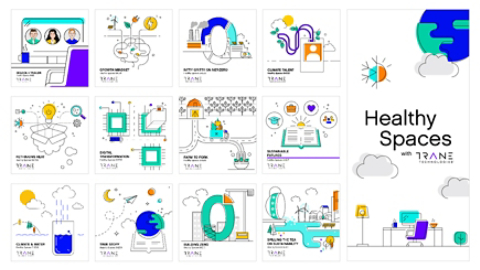[00:00:00] Rasha Hasaneen: When we think of places that might not have the greatest air quality, our minds usually turn to crowded and stuffy spaces like shops, restaurants, office - even congested streets. But rarely do we consider that our own homes might also make that list.
[00:00:14] Jennie Bergman: Some of the natural things within our homes, our carpet, some types of paints, cleaning chemicals, and otherwise can emit VOCs and some to extent that can be harmful.
[00:00:27] Rasha: And with the holidays rapidly approaching, there could also be a very festive culprit potentially damaging our air and health.
[00:00:35] Dr. Emer Duffy: There's a really interesting study cooking different types of meals. One interesting finding from the study was that they had very high emissions of particulate pollutants coming from the Thanksgiving meal.
[00:00:46] Rasha: That's Jennie Bergman, Indoor Environmental Quality Product Manager at Trane Residential, and Dr. Emer Duffy, Science Lead at Allergy Standards Limited. As Indoor Environmental Quality Product Manager, Jennie's work is helping us to understand what is happening in our home environments as well as finding solutions to our indoor air, light and temperature needs. And through her work at Allergy Standards Limited, Dr. Duffy is progressing the ASL's mission to create the healthiest possible indoor environments and is responsible for developing and maintaining the organization's certification standards.
In today's show, we'll be taking a step away from commercial spaces to the comfort of our homes to find out what effects the air quality of our residences and how we can make them better for ourselves and our families. I'm Rasha Hasaneen and you're listening to Healthy Spaces with Trane Technologies, a series of conversations that explores the world of indoor environmental quality from the inside out.
Building owners and employers have a vested interest in ensuring their spaces meet particular air quality standards, so it's no surprise that a growing number are aware of issues surrounding the quality of indoor environments. But without a financial or legal incentive to ensure the best air quality in their own houses, do homeowners and families think about the air they breathe at home? According to Jennie, yes, they do. And they have a few things they're particularly worried about.
[00:02:20] Jennie: Indoor air quality is a top concern of homeowners today. Now with more time spent at home, there's bigger awareness of what's happening in the home and the comfort within it. But to talk broadly about the concerns within the home, as we've surveyed over the years, the top concerns are dust, pollen, mold spores, bacteria, and household odors. What's notably different though in the last few years, particularly as a result of COVID-19 is the response and indication from homeowners around the concern related to viruses.
[00:03:01] Rasha: And that's common in commercial spaces. And it's interesting that it's also common in the home, right? We're pretty accustomed to - you have a sick kid who maybe caught something at school and comes home and everybody else gets sick - which I think if it's a cold, it was a whole different world. And now with COVID it's so front and center in people's minds. And you know, we've heard a lot about opening windows and bringing in outside air. And for a long time, I think people believed that air quality outside is really worse than the air we breathe indoors. But according to the EPA levels of indoor air pollutants are often two to five times higher than outdoor levels. Particulate matter seems to be one of the main culprits here. Maybe you can talk to us a little bit about that.
[00:03:48] Jennie: So, it's interesting. We have done some research as a part of indoor air quality monitoring, and in a study of over 50,000 homes, over 70% had elevated particulate matter in the home, which really just affirms what you're saying, that particulate matter is a problem. And why is it a problem? So, there's different levels or size, diameter or particles, and really, it's that fine particulate matter, that 2.5 microns and lower, that has impacts to human health. We've got these really great natural immune responses that help us get rid of a lot of those larger diameter particles, but our body's not capable of filtering that smaller particulate. And that's what infiltrates into our lungs and airstreams and bloodstreams as well, and can cause cardiovascular issues, respiratory... and the problem is that particulate size 2.5 is actually very common in homes: smoke, auto emissions, bacteria, mold, spores, household dust, pet dander, it can all be that size, and often very frequent in homes.
[00:05:07] Rasha: And we've got a lot of really great tools in the house that can address things that you can't see, right? Whether it's dust or other types of particulate matter, but a lot of times it addresses some, but it breaks down others. And so, you end up in this really interesting spot. What about odors? I know we talk about in some of our other episodes about volatile organic compounds, and that's kind of a really big word, but I think in the home, it manifests itself a lot of times as odors. So, what about odors and humidity? What role do those play in the spread of pathogens and viruses and bacteria, et cetera?
[00:05:50] Jennie: Yeah. These are a really a substance that many are not aware of, but we think of these as odors, and these can be emitted from some of the building materials of our home. But it also comes from kind of the traditional cooking smells or pet odors or cleaning and chemicals, perfumes, even. And the thing about volatile organic compounds is they are gaseous. So, they, they aren't captured through your standard particulate, um, filter methods that residential homes typically have in place. And so the way you resolve those issues is much different within the home. So, to talk to the VOC or older parts, specifically, those pesky odors are a problem, but we often don't realize. Though some of the natural things within our homes: our carpet, some types of paints, cleaning chemicals, and otherwise, can emit VOCs and some to extent that can be harmful.
But when it comes to humidity - humidity is often thought about as a comfort aspect within the home, but it also has an impact on the mitigation of viruses because as you sneeze out virus droplets in drier air, they have an instantaneous effect of shrinking, which effectively causes them to remain airborne for a longer period of time. And just to give you a sense of the magnitude, a droplet that diameter of about a half of a micron stays in the air for 41 hours, but a droplet the size of 10 microns only stays in the air for an hour and a half. So significant difference humidity can add to the effect on viruses.
[00:07:42] Rasha: Even though many of us are starting to become conscious of the quality of the air in our homes, as Jennie pointed out, a lot of us are still unaware of the impact our habits have on it. And just as importantly, many of those also don't realize how something as simple as humidity could have such a huge impact on a very top-of-mind concern at a global level right now - the spread of viruses. But, as Dr. Duffy explains, there is a significant group of people who have always tried to be aware of the environmental quality of their homes because the failure to do so could have drastic consequences for their health.
[00:08:28] Emer: Indoor air quality is a particular concern for people who are affected by asthma and allergies. And of course, it's a broader benefit to everyone to have a healthier home. So, the asthma and allergy friendly certification program that we run in cooperation with the Asthma & Allergy Foundation of America, aims to help people to identify products that will make a genuine difference to their indoor environment in terms of improving the indoor air quality.
[00:08:50] Rasha: So maybe just for our listeners, you can give us a sense of how big the issue is. So how big is the population of people with allergies or asthma and how has that really changed over time?
[00:09:03] Emer: So, asthma and allergies have been increasing in many developing countries since the 1980s. Now there are over 25 million Americans who are affected by asthma and over 15 million effected by allergies every year. So these are big numbers and this currently no cure for asthma. So treatment would generally involve a combination of medication and avoiding triggers. Allergies, similarly, are a very common chronic disease and occurs when the body's immune system sees a substance as harmful, and it overreacts to that substance. And this can even go to be a more serious or even life-threatening reaction in some cases where you have trouble breathing, your throat can swell and that can occur in a reaction that's called anaphylaxis.
[00:09:47] Rasha: That's super scary. And those numbers are huge. Maybe you can share a little bit about what some of the triggers are and how people can think about reducing them.
[00:09:57] Emer: So, avoiding triggers is really important in managing the two diseases as I mentioned. And some common triggers that you might encounter in your own home can include dust mites, pollen, pet dander. For example, cat allergen can be very small in size. It can actually be airborne, so it can be floating around the room and can be breathed in and this can be a problem. We can also have mold growth in parts of the home that are kind of humid. And mold, when it's growing, can generate spores and these can then float through the air and can be problematic for people with sensitive airways. And then of course there's all the different materials we bring into our homes as well and building materials and consumer products. And some of these can contain certain chemicals that are allergen or sensitizing as well. There's a lot of really interesting research going on in the area of indoor air quality. The kitchen is a really interesting room to focus on. So cooking is an activity that we all perform, and cooking can release oil, droplets, particles, and other volatile chemicals into the air. There's a really interesting study in the US, called the HomeChem study. They recently looked at emissions from cooking activities. They were performing all sorts of different cooking and cleaning activities, and one interesting finding from the study was that they had very high emissions of particular pollutants coming from the Thanksgiving meal that they cooked together. I've also seen some really interesting research in Lawrence Berkeley National Lab, where they studied how effective the extractor fan was during cooking to see if could it remove pollution from the breathing zone. They found that it was much more effective at removing pollution when you were cooking on the back burners of the stove, and so that's a nice take-home message. If you can always use the exhaust fan, I'm trying to cook on the back burners.
[00:11:43] Rasha: So Emer, what about other rooms in the home? Is there any research out there about anything outside of the kitchen? I know through the pandemic, we've all sort of shifted a lot of our activities from schools and offices to our homes and a lot of our rooms are starting to move from being sort of simple, single use - they're shifting. Are there any other rooms you may have some interesting research on?
[00:12:09] Emer: Healthy indoor air is really important if we think about the home office, wherever that may be in our home, whether it's the kitchen or the bedroom or the spare room, or even a dedicated home office. I think it's really important to ensure you have healthy indoor air in there. There's some really interesting research out there showing that poor indoor air quality can reduce people's cognitive performance. There was a study from Harvard in 2019 that looked at decision-making performance in workers. They found that when there were high levels of carbon dioxide and volatile chemicals in the air, the worker’s decision-making performance was reduced. So, if you want to try and improve indoor air quality in your home office, it's important to ensure that there is a good air flow in the room. You can do this by opening doors, between rooms in your home, moving furniture, away from the walls. And if you need to, you could use a fan to help improve air flow. And it's also a good idea to try and avoid using strong scents in your home office. I know it's tempting to burn maybe a scented candle or something, but these can sometimes release volatile chemicals that may be respiratory irritants.
[00:13:16] Rasha: With so many of us using our residences as a place of work as well as rest, the onus has fallen on to the individual to ensure the best air quality at home. But in an increasingly environmentally conscious and financially careful world, homeowners and developers tend to prioritize efficiency over all else. And these energy saving solutions, unfortunately, tend to come at the expense of indoor air quality.
[00:13:43] Jennie: There've been some incredible advancements in home building technologies that have improved energy efficiency within the home. But the way that homes are achieving those energy efficiency ratings is through more insulation, tighter window construction. But the unfortunate effect of that is the air inside of the home doesn't breathe. It doesn't have that natural ventilation, which causes this buildup of poor air quality and mold and otherwise. And so really what home builders are doing to resolve those issues is improve ventilation or that exchange of outdoor air to keep that home improved with air quality.
[00:14:54] Rasha: Which also has some impacts on energy efficiency. But, you know, there are some really amazing technologies available today to help us tackle those issues. Maybe you can talk to us a little bit about what those are and what is available to us today.
[00:15:10] Jennie: What we find many of our home builders leveraging is technologies like ERV’s, energy recovery ventilators, that help recapture some of that humidity and temperature from the exchange of air to prevent the additional conditioning of that air as it circulates throughout the home. It's an amazing technology and really has allowed us to advance ventilation within the home without suffering some of the negative consequences of energy as a result.
[00:15:40] Rasha: And I think, I think as homeowners start to really get educated on this, we are going to see a lot more of this controlled ventilation. So when we're doing ventilation in a way that allows us to very deliberately manage energy, I think we are going to see a lot more of that with homes moving forward.
Let's take this all down to what homeowners can do today to really understand the air around them. Can you talk a little bit about home air quality monitors and why they are so eye opening for people who use them?
[00:15:49] Jennie: Understanding the conditions within your space through a monitoring device is really paramount to any further action you may take in terms of mitigating action within the home. The thing about odors or particulate matter or any of these, some conditions that can impact air quality is largely they're event-driven. And so indoor air quality monitors give you the insight into the behavior within your home that can help you to deduce where the triggers are coming from. Those triggers can be controlled or really you need supplementary technologies to help mitigate the problems that you're experiencing.
[00:16:57] Rasha: That's absolutely true. I know I've got one and there's some things I've changed and there's some things I can't change. Like I'm not going to stop doing my hair anytime soon, but I will open a window when I do it, have you used one in your home?
[00:17:10] Jennie: I have, I use it for a couple of different purposes, but we actually originally got an indoor quality monitor when we replaced the carpet in our home. My son has some severe eczema issues and is very reactive to chemicals and other things and can happen on the drop of the hat. So, what we did is, knowing even if the low emissions carpet that we had purchased, we knew that the glue that they would be using and some of the epoxy, would cause some BOC elevation. So, we installed a monitor in our son's room and in some of the other living spaces so that we could actually remotely monitor the space while we lived apart from the home for a while, just until we knew it was safe. So once the levels of VOC got back to kind of normal conditions, we came back into the home and luckily, we avoided a couple episodes of eczema reaction as a result of it.
[00:18:18] Rasha: Jennie was able to take charge of this situation because she was able to accurately assess the conditions in her home.
And for others to truly be able to manage the air quality in their homes, they too need the ability to understand what is affecting those all-important VOC, allergen and pollutant levels. And while some VOCs and allergens like cleaning products, smoke or pet dander might be obvious irritants, Dr. Duffy explains that there's another, less obvious, source of indoor pollutants.
[00:18:49] Emer: So I'm really interested in understanding the link between our environment and our health. And in the past I've worked as a research scientist before I joined ASL, I worked on some really interesting projects. One of which was looking at the emission of gases from human skin. And during this time I learned that all of the gases that come from our skin are actually contributing to the indoor air pollution and all the environments that we spend our time in. So, if you think about when we gathered lots of people together in a room and sit together for a few hours, say in a meeting room or in a lecture. It may be apparent that the room gets stuffy and maybe there are odors. And these are as a result of all the people breathing into the room and their skin is emitting gases into the room and all of the things that we put on our skin as well.
So we all wear personal care products, and these are all contributing, volatile chemicals to indoor air. And all of this work then prompted another idea to develop sensors that would enable people to track indoor air quality and homes in a really simple and easy way during the project, I used the sensors to measure the volatile chemicals coming off when heating up different cooking oils and found that the highest emissions were produced when cooking with sunflower oil, which is really interesting.
And then after that I was lucky enough to deploy the sensors in a household study as well. So, I travelled to Finland I worked with a collaborator there to investigate air pollution in different homes and we saw increased levels in the kitchen and the living room where we had cooking things like burning scented candles going on. And we also looked at the home office, much lower pollution levels there were the only activity recorded during the study was office work. So, low cost sensor technology like this could be used for indoor air quality monitoring and gathering data in households, maybe through a citizen science initiative or maybe it would even enable crowdsourcing of air pollution data. That was a really exciting project.
[00:20:27] Rasha: That's super interesting. And the ability to also very quickly see whenever something you're doing is, is creating an air quality issue, I think, can also change people's behavior. I don't think people will stop cooking, but that they might stop burning a scented candles as it relates to, to volatile compounds in the air. You know, when I put my air quality sensor in my room, it did actually change how I behaved. I found myself opening the window more. I didn't necessarily change the things that I needed to do, but I did find myself doing things that were improving the quality of the air after I had those activities, right. And so super, super interesting research.
[00:21:10] Emer: Yeah. That's really nice, you're well-informed, you can understand your impact on indoor air quality and then you can actually try and mitigate that, which is great. I think there's great potential for this technology. It can really help people to learn about how their behavior affects their environment. And then you can imagine that a sensor might alert an occupant to a particular type of pollution, or maybe it can even provide tips then as to what to do. So maybe if it knows that the level of particulates are high, it might encourage you to open the windows.
[00:21:41] Rasha: With poor air quality having such a drastic impact on human health and cognitive function, the importance of having low-cost sensors can't be emphasized enough.
By simply equipping homeowners and occupants with the tools they need to monitor their indoor environmental quality you can empower them to take action against a swathe of issues from high VOC levels to mold. As we draw to a close, I wanted to know what advice Dr. Duffy and Jennie had for households wanting to improve their air, health and even their peace of mind.
[00:22:17] Emer: I would say, if you can ventilate, first of all, you should. If it's possible to ventilate with clean outdoor air, that's a really good place to start. However, that might not be possible for everyone. If you're living in an area where there are wildfires, or for example, if you have a pollen allergy and the pollen counts are very high, you might not want to open your windows. In that case, air filtration can help. So you could use the HVAC system with a high efficiency filter.
If you don't have that, you could look for a portable air cleaner and that's the one you could place in whatever room you're using at the time and run that to filter out particles and allergens from the air. I think it's also really important to look up source control. So reducing or removing triggers as much as possible. Cleaning is an important thing to mention here, regular cleaning, including, vacuuming, and surface cleaning to remove allergens and dust from the environment. We've talked about the importance of using the exhaust fan when cooking. And I think it's also important to use that in the bathroom as well after a shower, so that you're going to reduce the level of humidity to try and prevent mold from growing on certain wet surfaces.
Another point I think is worth mentioning is to think about the things that you bring into your home. So make sure you're making an informed choice when you're purchasing new products. Do your research and look for products that have undergone independent testing and certification. It's a helpful way to find products that have been backed by science.
[00:24:20] Jennie: If you are new to this, the paramount thing you can do is an invest in an air quality monitor, which will give you some understanding into what's happening uniquely in your space. You have to know what the problems are, so you know where to go solve them. Otherwise, it's kind of a shot in the dark. So that's my piece of advice.
[00:24:36] Rasha: With holidays drawing closer, Jennie and Dr. Duffy’s advice couldn't have come at a better time. And as we start to work out how we're going to cook for family and friends, we should also spare a thought for how we're going to manage the increase of pollutants from our kitchen, and even our guests.
You've been listening to Healthy Spaces with Trane Technologies. I'm Rasha Hasaneen. For more information on our conversation with Dr. Emer Duffy and Jennie Bergman, see the show notes on your podcast app. Don't forget to follow us to hear new episodes. Thanks for joining us. We'll see you next time.






















